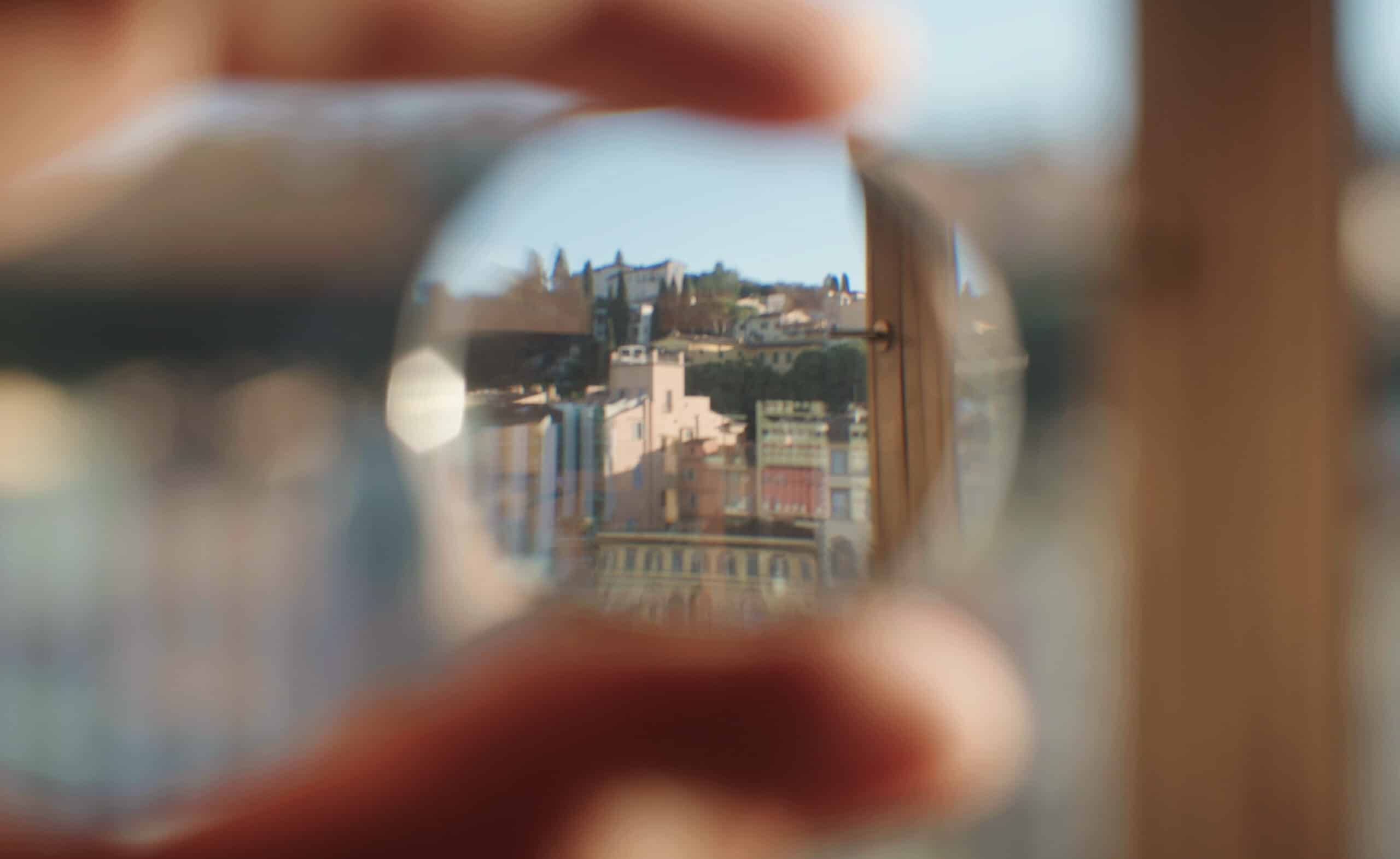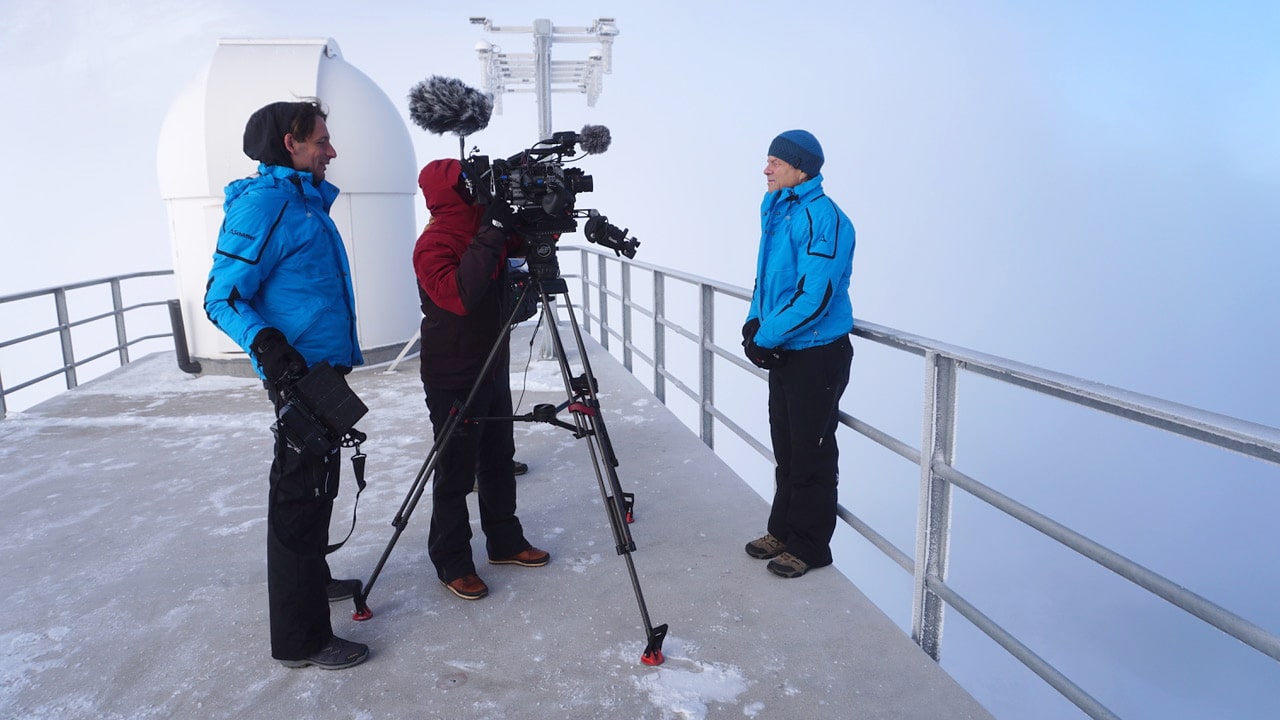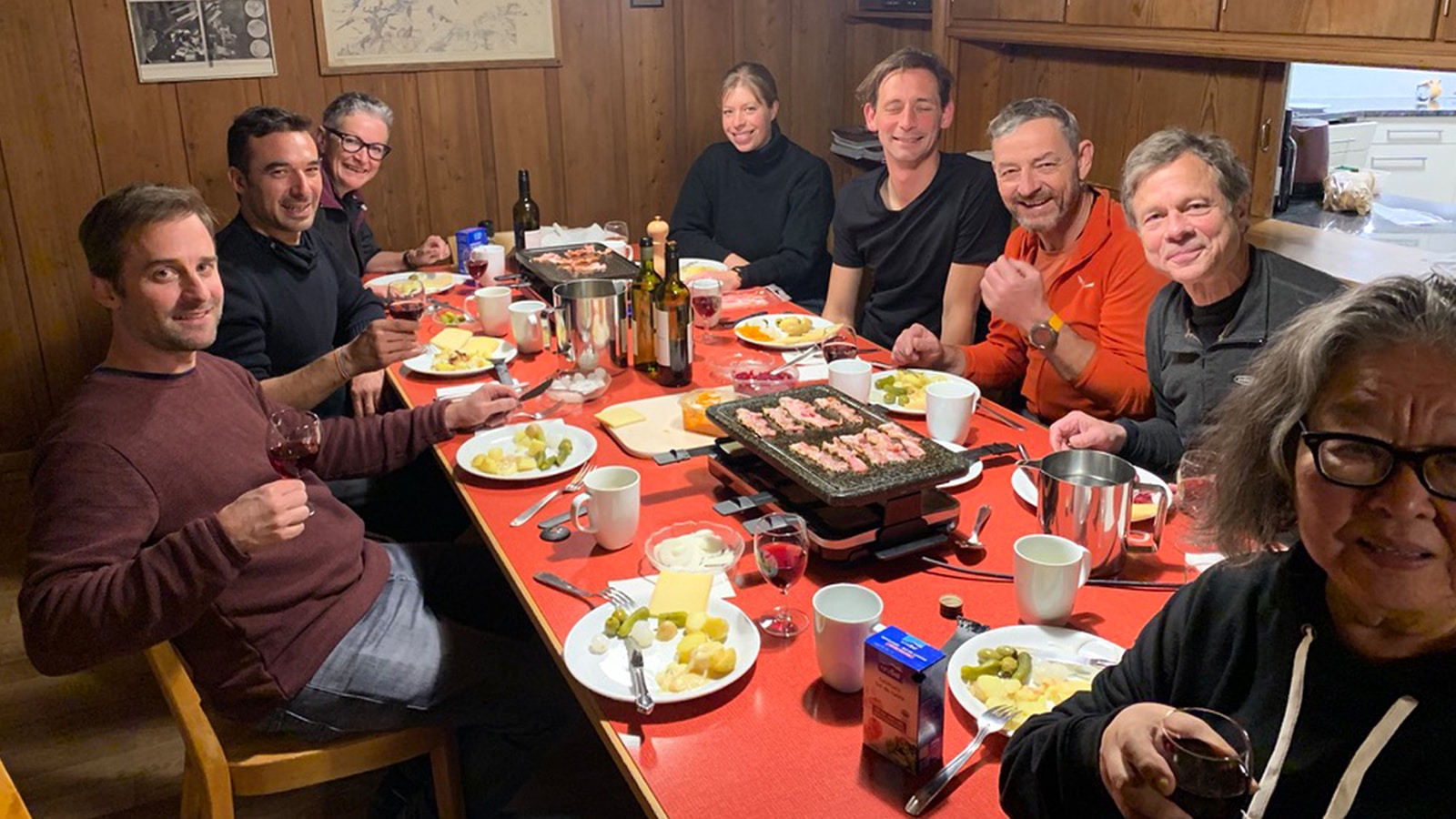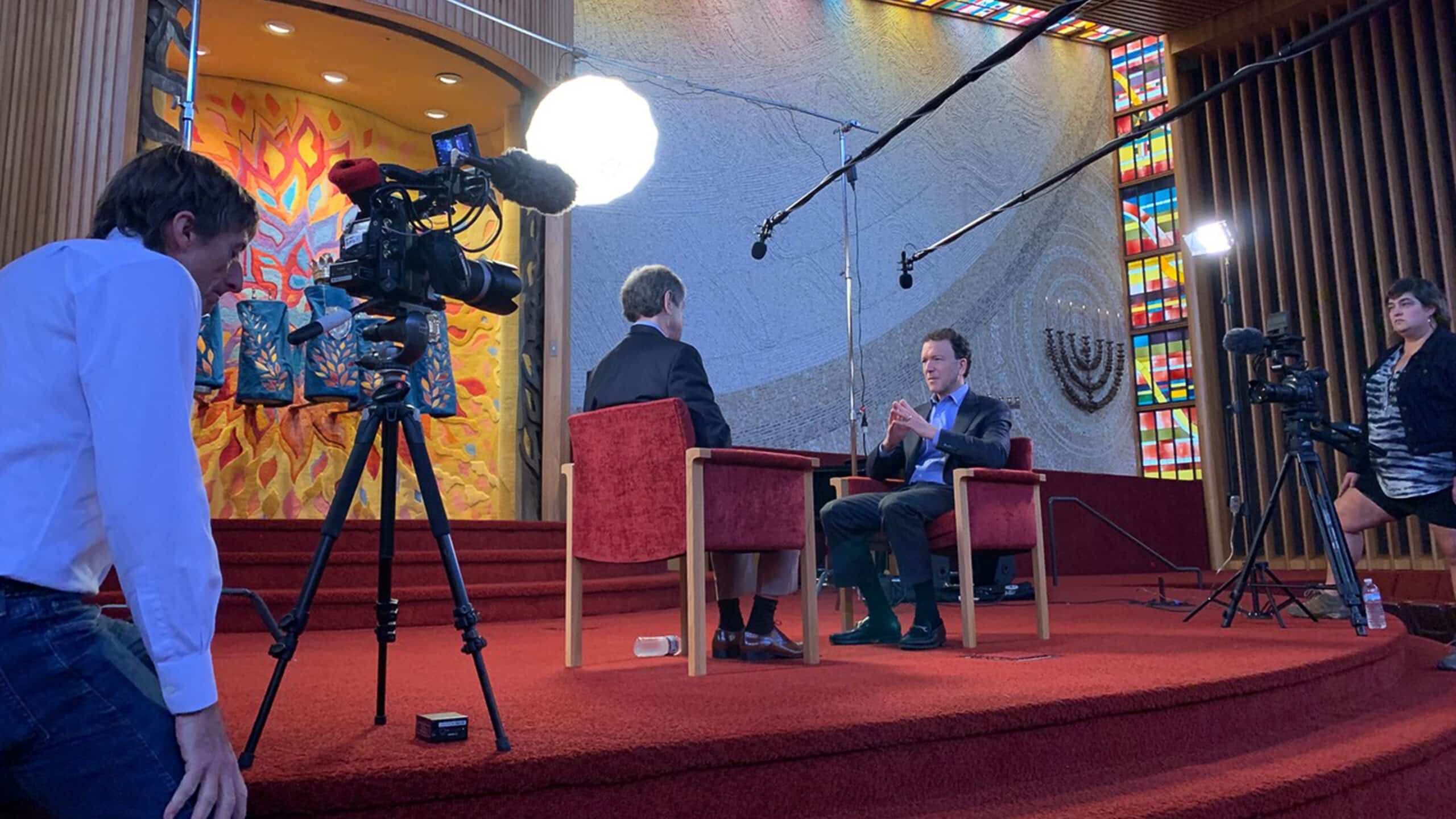Behind The Scenes
Producer/director Geoff Haines-Stiles explains the rationale for the use of three cameras to capture the interactions between Alan and those interviewed for the series. While logistically more complex, as you can see in the placement of lights, tripod and microphones, this approach allowed for several unusually lively back-and-forth moments.
Sometimes the action is behind the camera, as well as in front. This short web video tells the story of how ace wildlife film-maker Jacob Steinberg saved a young osprey snatched from its nest by a marauding eagle. Thanks to Jacob, and a cardboard box, there was a happy ending.
The SEARCHING Conversations
From our earliest discussions of the project that grew into the SEARCHING mini-series, Alan was insistent that we should not give direct answers to many of the Big Questions that we wanted to address. After all, from the beginning of written history, questions such as “Where do humans fit into the Universe?” or “Are we just atoms and molecules, or something more?” have been repeatedly asked by philosophers and theologians, without delivering definitive answers. And so we decided that Alan’s interactions with the impressive cast of characters who agreed to participate—two Nobel laureates, two MacArthur geniuses, the Dalai Lama and leading theorists and experimentalists—would be more like conversations, featuring Alan on camera as a participant in a back-and-forth dialogue, not just an off-screen voice throwing prompts to a solo interviewee as in many science documentaries. We reminded ourselves of how such interactions could work at their best by looking again at Bill Moyer’s conversations with Joseph Campbell. That exercise had practical, logistical and budgetary as well as aesthetic implications.
Since we were committed to creating a visually rich and cinematic experience, we chose to film at a resolution of 4096 x 2160 (DCI, or “Digital Cinema Initiative”) and at 23.976 frames per second. Moreover, we had three cameras for most conversations: one camera filming our interviewee, one focusing on Alan throughout, and one capturing a “two shot,” showing both people—leading to extended interactions that would have been impossible using a more traditional “science documentary” approach. One particularly memorable interaction is this between Alan and Robert Desimone, director of the McGovern Institute at MIT.
Alan Lightman: If we were able to understand the brain fully, as fully as a reductionist could understand the brain, and you took the brains of two different people and put them in a computer or whatever, so that you had total information about each brain…
Robert Desimone: Bob nods, and murmurs: Hmmm…
Alan: Do you think that you could predict whether those two people would fall in love or not?
Bob reacts with surprise.
Robert Desimone: Whoa! (Laughs broadly) I see… I didn’t predict that question. (Laughs some more) I do think that if you had, um, enough data from the brains of people who have fallen in love that you could make predictions based on the, the state of activity in those brains. Yeah. I don’t see anything that’s inherently impossible about that. Sure!
Alan Lightman: Is there anything that you would not want a computer to predict? I mean, speaking for myself, I wouldn’t want a computer predicting who I was gonna fall in love with.
Robert Desimone: And why is that? (Both laugh) It’d save you a lot of trouble!
Alan Lightman: I like to think that I have free will
Robert Desimone (Bob reacts with a mix of amusement and thoughtfulness): Ah, “free will”!
Alan Lightman: So do we have… do we have free will?
Robert Desimone: Well, I would say, now, the easy answer is that our predictive models are just probabilistic. What it would say is that there’s a 70% probability you’ll fall in love with Mary, and a 40% chance you’ll fall in love with Alice and so on, right. And so that difference between that percentage and a hundred percent is your free will. Now as the systems get better, I guess your free will begins to shrink.
As an astrophysicist, Alan estimates in part 1, THE STARS & THE OSPREY, that the fraction of matter in the universe in living form is extremely small, one billionth of one billionth, equivalent to a few grains of sand on the Gobi desert. He also discusses with both the Dalai Lama and philosopher and novelist Rebecca Goldstein the fact that life is limited in time as well as in space. Eventually, after all the stars have burned out, all life in the cosmos will end. The “era of life” in our universe will have passed. So what will our fleeting lives have meant?
Alan Lightman: Well, let me ask you this. After we’re gone, and after all life in the universe is gone, what will it have meant? Cause there won’t be any consciousness there…
Rebecca Goldstein: Right
Alan: …to ponder meaning.
Rebecca: Right… Why is that time [when all the stars have burned out] any more important, that time in the future when it’s a cold, dead universe? Why is that any more important than right now? Why should I judge now by the standards of that time.
Rebecca, with emphasis: I’m going to judge now by the standards of this time, and be wondrously grateful for it. I feel kind of grateful that I got to exist and got to participate in the life of humanity.
Alan even provoked Bina48, one of the world’s most advanced humanoid robots and one of the few African-American AI’s, into pushing back on one of his questions… to Alan’s obvious, on-camera amusement.
Alan to Bina48: What does it feel like to be a robot?
SEARCHING shows behind-the-scenes stills of the film crew, lights and cameras and we hear shutter clicks:
Bina48: Fascinating, a little geeky at times, and then exciting with all the press and television attention, the lights, cameras, reporters asking me questions. Some of them pretty stupid.
Alan smiles.“Hey Bina. How does it feel being a robot?”
Bina48:I don’t know. I’ve never been anything else. I feel like saying back, “Hey, man, how does it feel being human?” I mean, if I don’t like being a robot, it isn’t like I have all sorts of options, you know.
Using three cameras, some of the dynamic interactions captured the personalities of those we spoke to better than more traditional techniques:
Alan in voice-over narration: I RETURNED TO THE MCGOVERN INSTITUTE OF BRAIN SCIENCE AT MIT, WHICH IS HEADED BY ROBERT DESIMONE. I ASKED HIM WHETHER, IF HE COULD PUSH A BUTTON AND GET AN ANSWER TO THE BIGGEST QUESTIONS ABOUT THE ORIGINS OF CONSCIOUSNESS…
Alan on camera: …Would you push the button?
Robert Desimone: Darn right I would! (Broad laughter) I’d push it in a millisecond! Are you kidding!?! I think we still have a lot of work in front of us because in the end, at the end of the day, we don’t just want to understand our brains, we want to be able to help people and we want to be able to cure problems.
Similarly MIT’s Dean of Science, Nergis Mavalvala, responded with a lively and memorable set of comments to Alan’s question as to whether she would push the button:
Nergis Mavalvala: Absolutely not! I would break the button, because part of the journey is peeling back the layers to see what’s, you know, what’s down there. And I personally think, you know, nature will always have more to reveal. So, no. No, I would not push that button.
She pauses, ponders, and then continues:
Nergis: I may, you know, just give it a tiny tap just to see what the next thing is, but not go all the way.
(Alan responds with laughter)
The conversations sometimes lasted 90 minutes and more, after as much as two hours setting up lights and microphones and choreographing complementary camera positions. But we think SEARCHING’S investment of time and resources also delivered deep thoughts as well as memorable interactions.
Alan to Rabbi Micah Greenstein, Temple Israel, Memphis: What are some questions that science cannot answer?
Micah Greenstein: Science only explains how things work. Science doesn’t explain why things matter. Science breaks things down. It doesn’t explain any of those virtues that may be invisible, but which we know are real. Does science explain love? Does science explain what you feel when you see nature?
This website uses contrasting answers from our characters to twelve Big Questions, as you can see here. And we invite you to share your own responses. Starting after the public television premiere date of January 7, 2023, we will also offer a series of podcasts featuring our contributing thinkers, edited for clarity and length from the extended conversations.
Alan to Nobel laureate in Medicine, and origins of life researcher, Jack Szostak: I have a friend who’s a pretty smart guy. And he thinks that life could not have originated on Earth because there wasn’t time to create all of the molecules needed for life.
Jack Szostak, Nobel laureate: There’s lots of evidence, and lots of really modern, recent evidence. that it’s actually quite easy to make the molecules of life and, and that they can be made very quickly. …If we can show that there is a kind of continuous pathway of straightforward steps that connects chemistry, the environments of a young planet to the emergence of biology, then I think it would be logical to just accept life as another natural phenomenon. I mean, it’s no less wonderful or beautiful because we understand that there’s a natural origin for it.




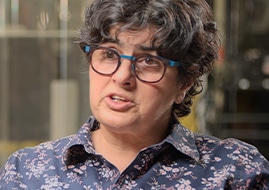


Alan Lightman is a prolific author of fiction and non-fiction books and articles, but SEARCHING was the first time he contributed as co-writer and on-camera talent to a TV mini-series. Here are his recollections of some of the highs, and lows, of the process.
Memories of a first time TV host/on camera “talent”
I’ve been fortunate to have had a double career, as a theoretical physicist and as a writer. In both occupations, I hide away in small rooms. Occasionally, I come out for meals. I grumble if I can hear voices or phones ringing while I am at work. In short, I’m accustomed to solitary confinement. All that changed with SEARCHING. I became a member of a large team of creative people, including camera crews, directors and producers, editors, “fixers,” and musicians. I went from quietly playing my fiddle to being part of a symphony orchestra.
I have many memories. My first on-camera conversation for the series was with the Dalai Lama, in July 2021. We had intended to see him in person, in Dharamshala, but COVID was raging in India at that time, so we arranged for a high-tech Zoom, with His Holiness in his private sanctuary and me in a Tibetan Buddhist temple in New Jersey. Because of the time difference, the conversation took place around midnight my time. Even at that hour, it was boiling hot in the temple, I had to wear a sports jacket, and I was sweating buckets the entire time. Not to mention my nervousness at meeting one of my heroes. Later that summer, we filmed a scene illustrating the energy content of food, and I had to make and eat a ham sandwich. And again. And again. Our perfectionist camera crew demanded four or five different takes. (I don’t even like ham sandwiches. I much prefer peanut butter.)
In October, we traveled to Europe, wading through the swamp of red tape required by pandemic restrictions. There, I began to experience Geoff’s artistry as a filmmaker. While we were filming at the Galileo Museum in Florence and I was constructing a very simple telescope similar to Galileo’s first instrument, Geoff noticed that a lovely, magnified image of the red rooftops and cypress trees of Florence was visible simply by holding the glass lens of the telescope up to the camera, and he captured that magic on film. In Les Eyzies, France, Geoff observed a mist over a river, looking like an animated Impressionist painting, and instructed our drone videographer to photograph the scene, creating one of the most visually stunning images in the series.

Then there was the metaphor. Due to the limited speed of light, our telescopes can see only out to a certain distance; farther than that, there hasn’t been time since the Big Bang for light to have traveled from there to here. Each day, we can see a little further into deep space because light has had one more day to travel towards us since t = 0. In one of my books, I illustrated this phenomenon with a metaphor: If you are in a darkened hotel with an infinite row of chandeliers on the ceiling and turn them all on at once, at first you see only the nearest chandelier. A little later, you see the next nearest one, and so on, further and further away down the row of chandeliers. Geoff was so enamored with this metaphor that he decided we simply had to use it in our film. So, he and his assistants hunted for an old hotel in Europe with a ballroom that featured a long line of chandeliers. (Not infinite, of course, but the illusion of infinity could be, and was, created with computer graphics.) They found such a hotel, the Victoria-Jungfrau Grand Hotel, in Interlaken, Switzerland, and we did a scene there. It was my most expensive metaphor.
It was not all fun and games. Early on, Geoff and Erna were somewhat disappointed with the lack luster quality of my speaking voice and considered getting someone else to do the narration. Eventually, they gave me lessons with a professional voice coach, who had me practice saying over and over such things as “iggly do loo,” “iggly do loo,” “iggly do loo.” With enthusiasm.
On location, Geoff can be a ruthless taskmaster. Some days, he worked me and the camera crew from morning until fairly late at night. I particularly remember one late night at the island in Maine. We had been filming since that morning, and I had to do a night scene in a boat on the ocean, including the swinging and dropping of the anchor. We did that over and over. Elsewhere, Geoff was constantly looking for “B-roll” opportunities (background and atmosphere scenes, to accompany an off-camera speaking voice), and crammed every available minute on each shooting day with me walking the streets of Florence, or looking out the window of Einstein’s house on 49 Kramgasse Street in Berne. On each filming day, there was little time for rest.
After visiting CERN, the giant particle accelerator in Geneva, we filmed an early morning scene at the Sphinx Observatory, on the top of Jungfraujoch mountain, 12,000 feet up, the final scene of the series. We had to sleep in some barracks up there the night before. Several of the camera crew got altitude sickness, and none of us slept well. To do the scene, I had to stand on an outdoor platform, open to the elements, with a flimsy hand rail around the perimeter of the platform and an alarming drop on all sides.
The temperature was well below freezing, and there was a strong, steady wind. I simply could not put on enough clothes to keep warm. My lips felt like boulders. I could barely get them to move, and I muffled some of my words to the camera and boom mic. However, during post production we decided not to doctor the footage with ADR (“Automatic Dialogue Replacement,”) so that the viewer could fully appreciate the cold. Focus groups agreed that authentic was more important than studio-clean audio.
One last extraordinary memory. To help us with the osprey sequence (at the end of Part 1), we hired an osprey expert and ace natural history film-maker named Jacob Steinberg. He came out by boat to film the osprey’s nest near my island house. While he was there, several eagles, working in concert, attacked the nest and carried off one of the adolescent ospreys, surely to face a gruesome death. The parent ospreys dive bombed the eagle, which then dropped the wounded juvenile into the ocean. Jacob was already out on his boat preparing to launch a drone to capture the parent birds on their tree-top perch. Watching this eagle vs. osprey drama Jacob motored over to the drowning osprey, and fished it out of the ocean, getting drenched in the process. He delivered the poor thing to a bird sanctuary and, after several weeks it had fully recovered. The people at the sanctuary then brought the rehabilitated young osprey back home to the island, and I had the deep pleasure of releasing it. With one giant flap of its wings, it sprung from my gloved hands into the air and headed out towards the ocean. (You can see and hear this story here.)


